Notice to Quit Samples
-
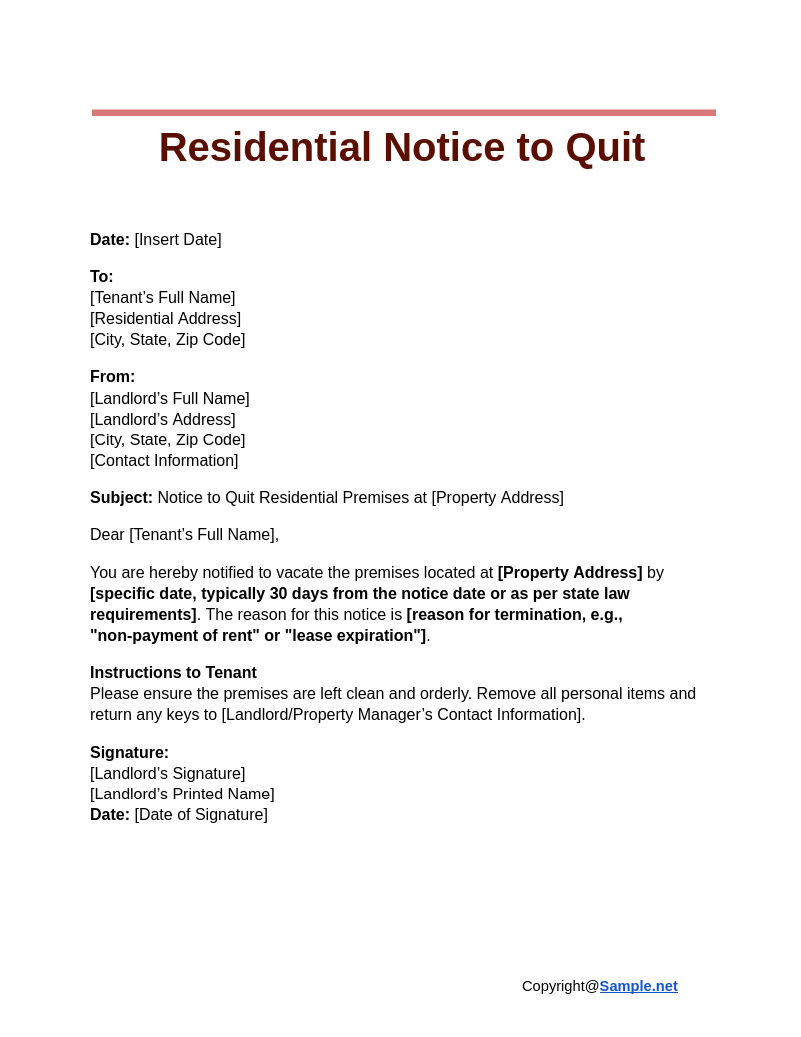
Residential Notice to Quit
download now -

Lodger Notice to Quit
download now -
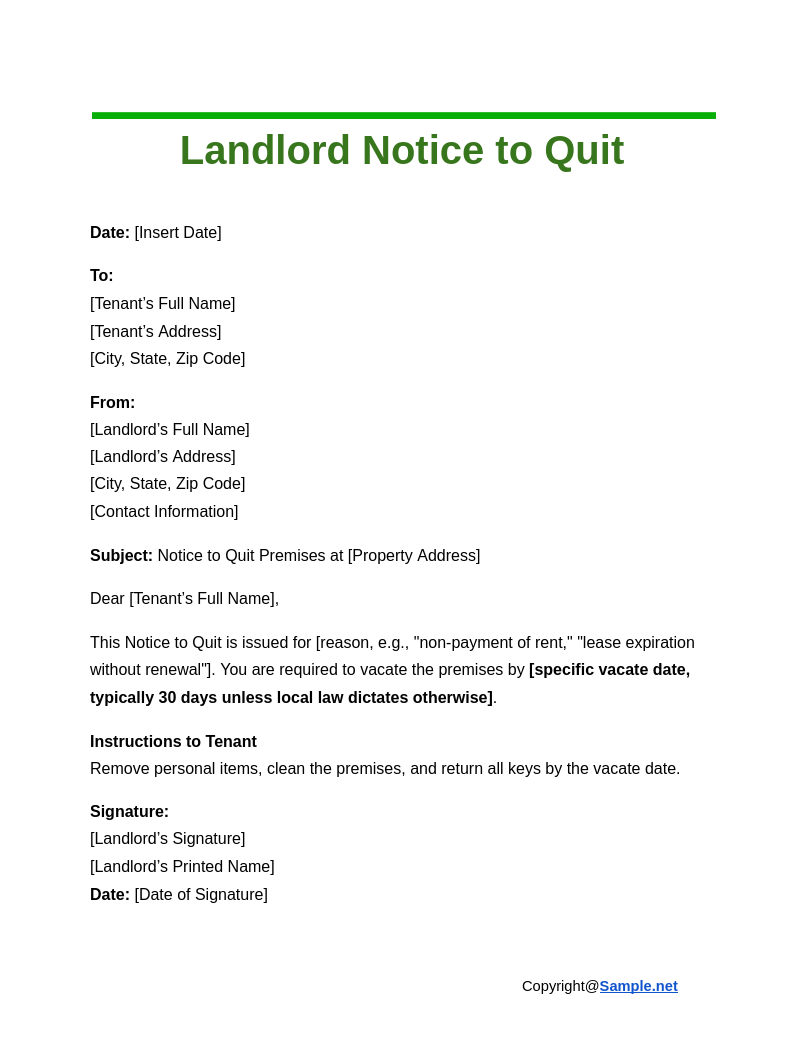
Landlord Notice to Quit
download now -
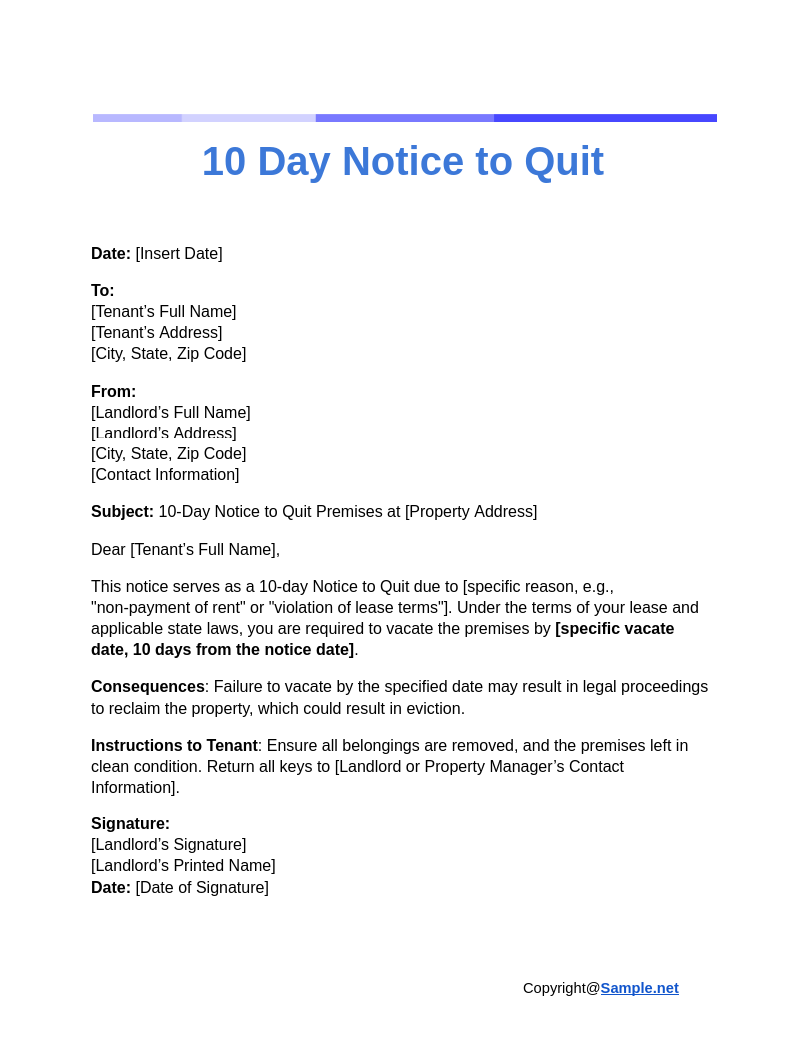
10 Day Notice to Quit
download now -
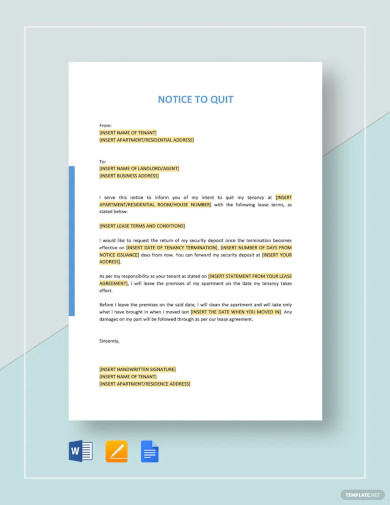
Notice to Quit Template
download now -
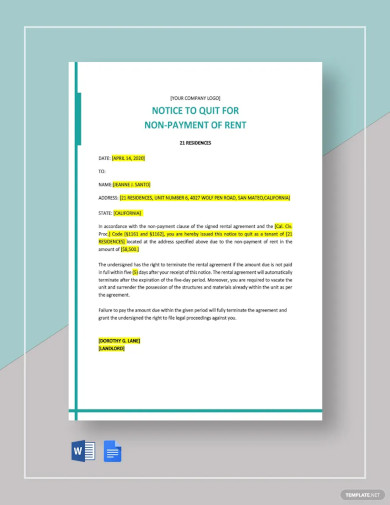
Notice to Quit for Non-Payment of Rent Template
download now -

Sample Notice to Quit for Non-Payment of Rent Template
download now -
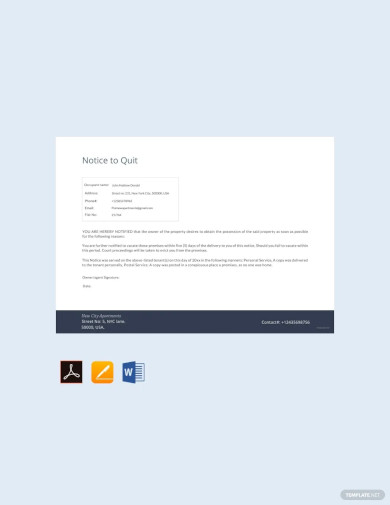
Editable Notice to Quit Template
download now -
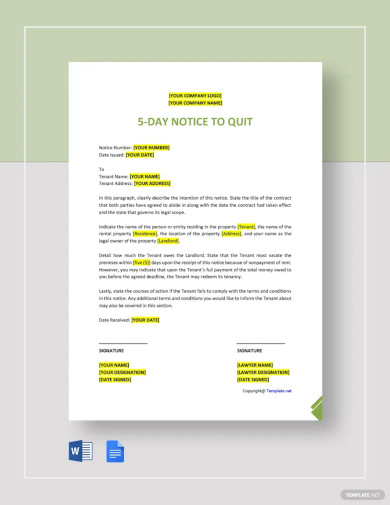
5-Day Notice to Quit Template
download now -

Five (5) Day Notice to Quit Template
download now -
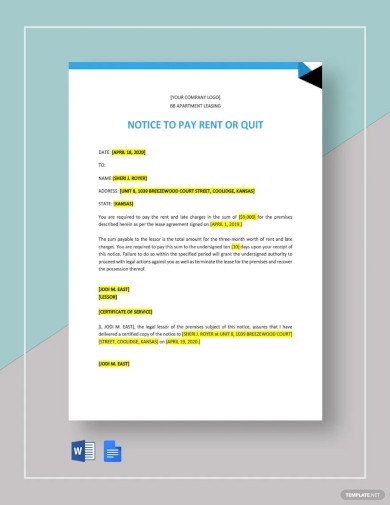
Notice to Pay Rent or Quit Template
download now -
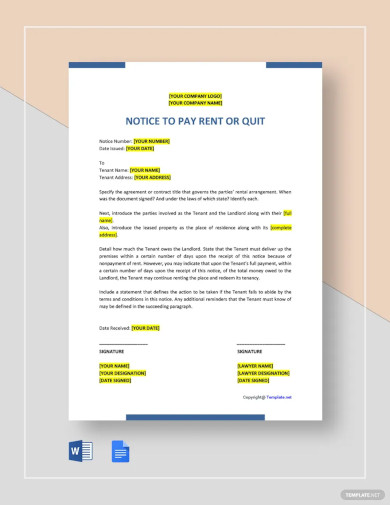
Sample Notice to Pay Rent or Quit Template
download now -
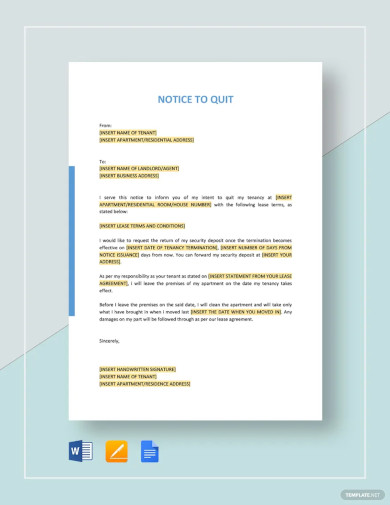
Notice to Quit Template
download now -
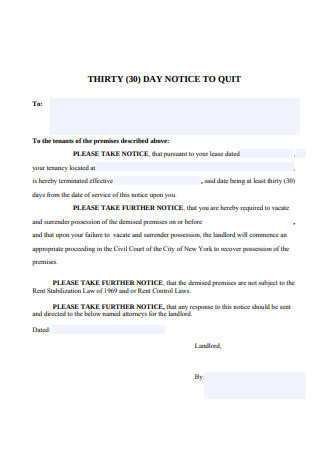
Thirty (30) Day Notice To Quit Sample
download now -
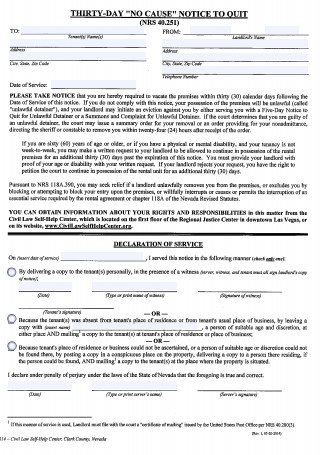
Basic 30-Day Notice to Quit
download now -
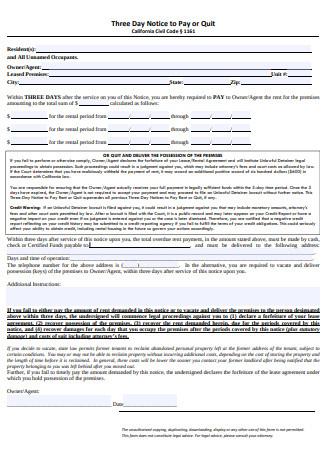
Three Day Notice to Pay or Quit
download now -
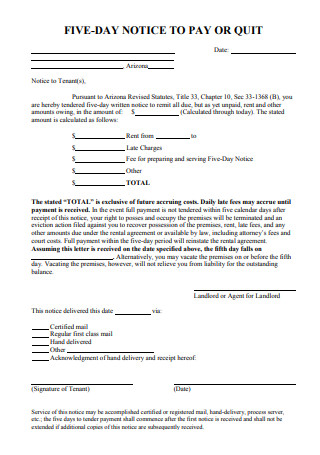
Five Day Notice for Non-Payment of Rent
download now -
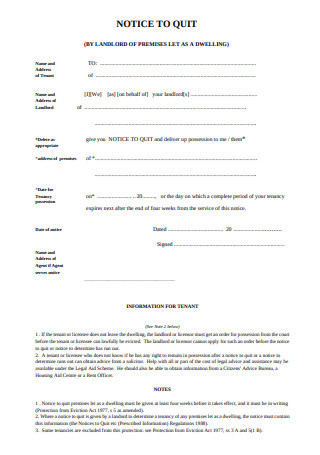
Notice to Quit Example
download now -
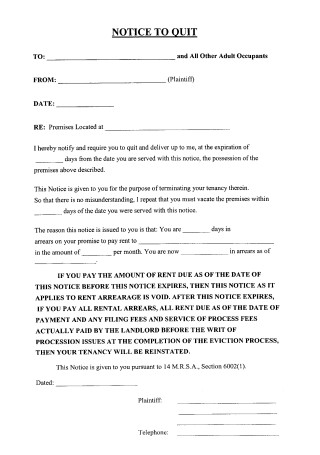
Form of Notice to Quit
download now -
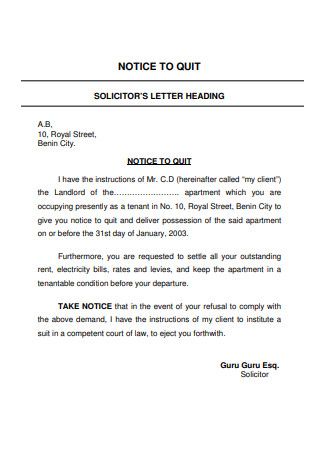
Basic Notice to Quit Premises
download now -
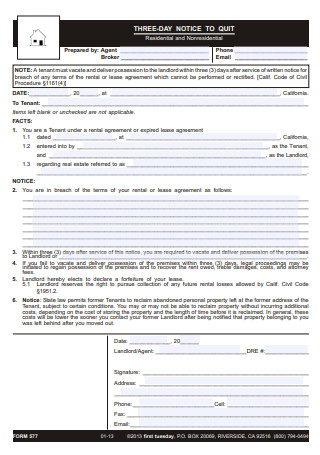
Three Day Notice to Quit
download now -
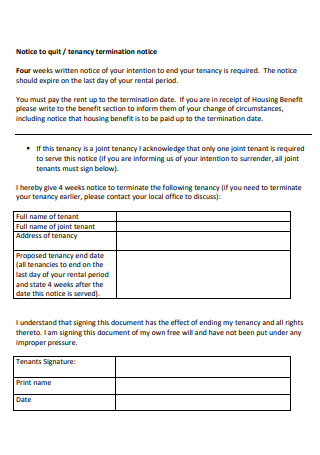
4 Week Notice to Quit / Tenancy Termination Notice
download now -
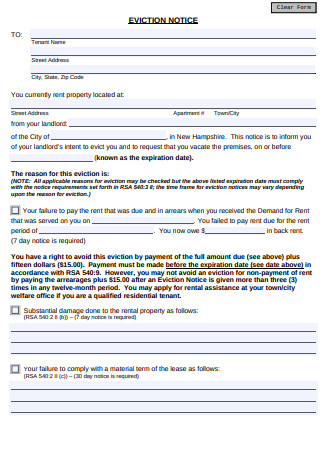
Eviction Notice
download now -
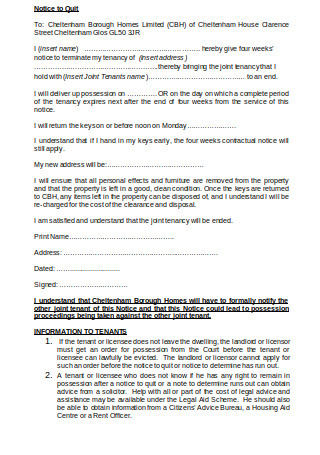
Notice to Quit
download now -
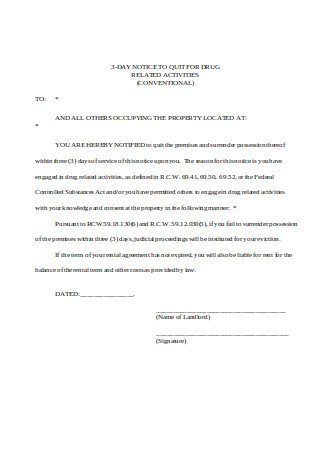
3-day Notice to Quit for Drug
download now -
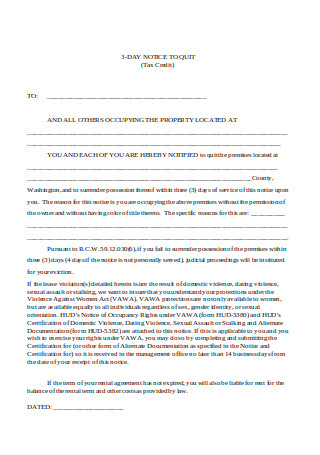
3-day Notice to Quit
download now -
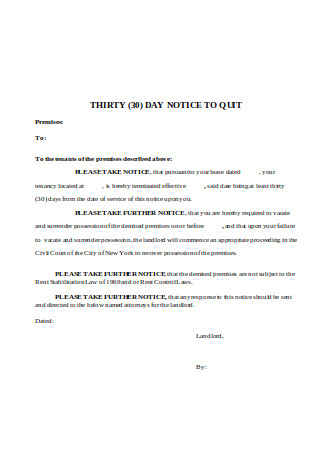
Thirty (30) Day Notice To Quit
download now -
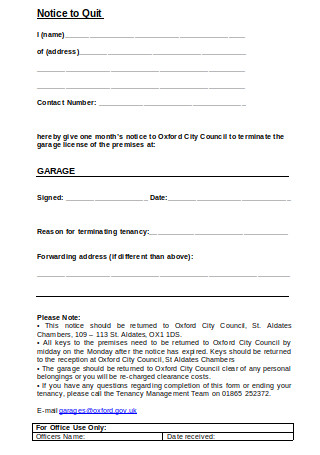
Formal Notice to Quit
download now -
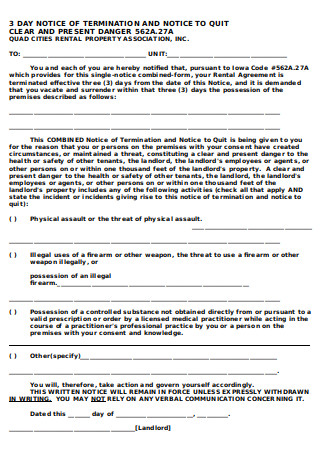
3 Day Notice of Termination and Notice to Quit
download now -
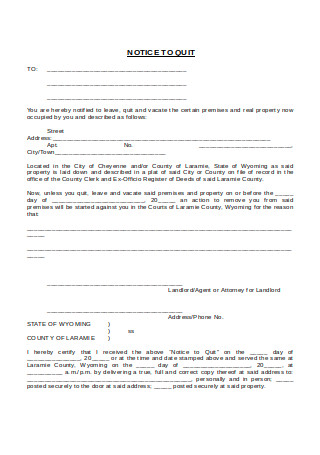
Simple Notice to Quit
download now -
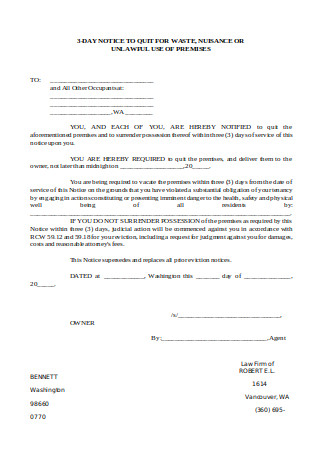
Three Day Notice to Quit for Waste
download now -
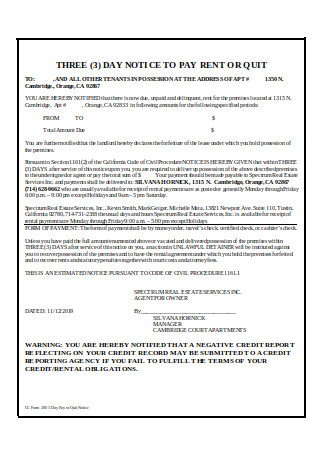
Three (3) Day Notice to Pay Rent or Quit
download now -
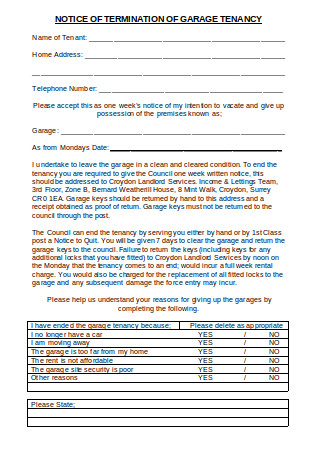
Notice of Termination of Garage Tenancy
download now -
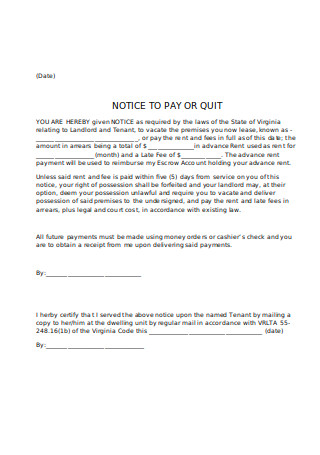
Rentals Notice to Quit
download now -
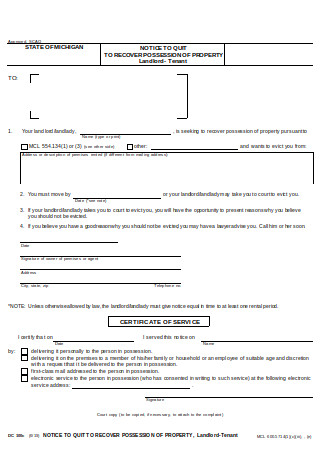
Notice to Quit Termination of Tenancy
download now -
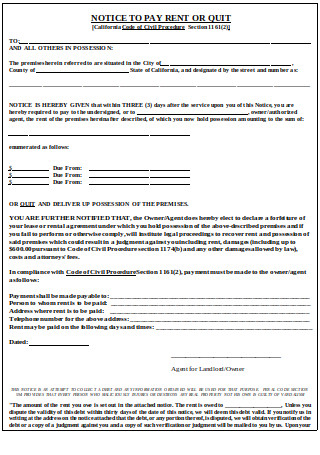
Notice to Pay Rent or Quit
download now -
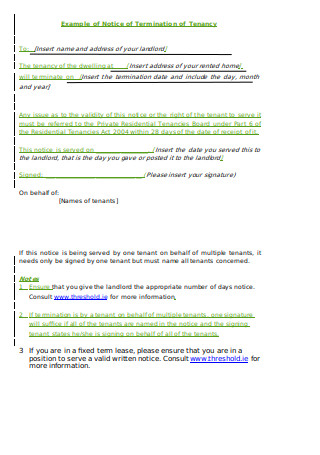
Sample Notice of Termination by Tenant
download now -

Sample Sixty (60) Day Notice to Quit
download now -
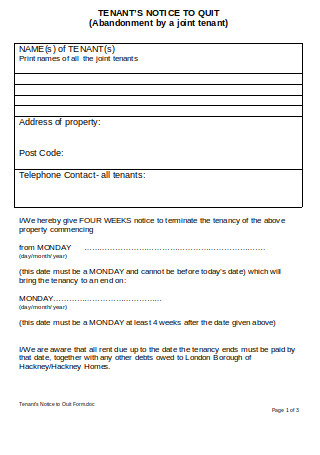
Tenant’s Notice To Quit Form
download now -
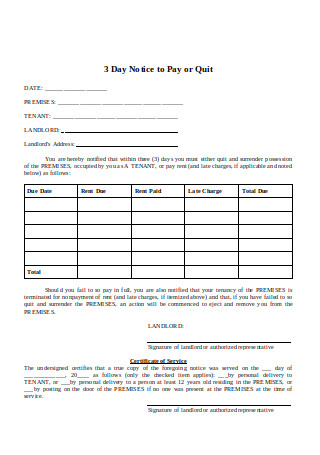
3 Day Notice to Pay or Quit
download now -
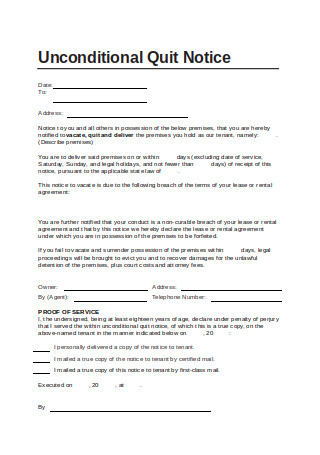
Unconditional Quit Notice
download now -
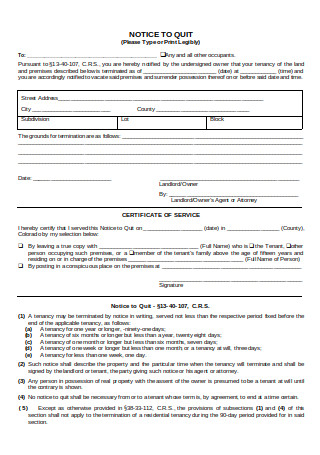
Formal Notice to Quit Form
download now
FREE Notice to Quit s to Download
Notice to Quit Format
Notice to Quit Samples
What is a Notice to Quit?
Types of Notices to Quit
How to Create a Notice to Quit
FAQS
When can a landlord issue a Notice to Quit?
How much notice must be given to tenants?
Can a landlord issue a Notice to Quit without a reason?
What are the legal requirements for delivering a Notice to Quit?
What should a tenant do if they disagree with a Notice to Quit?
What is the difference between a Notice to Quit and an eviction?
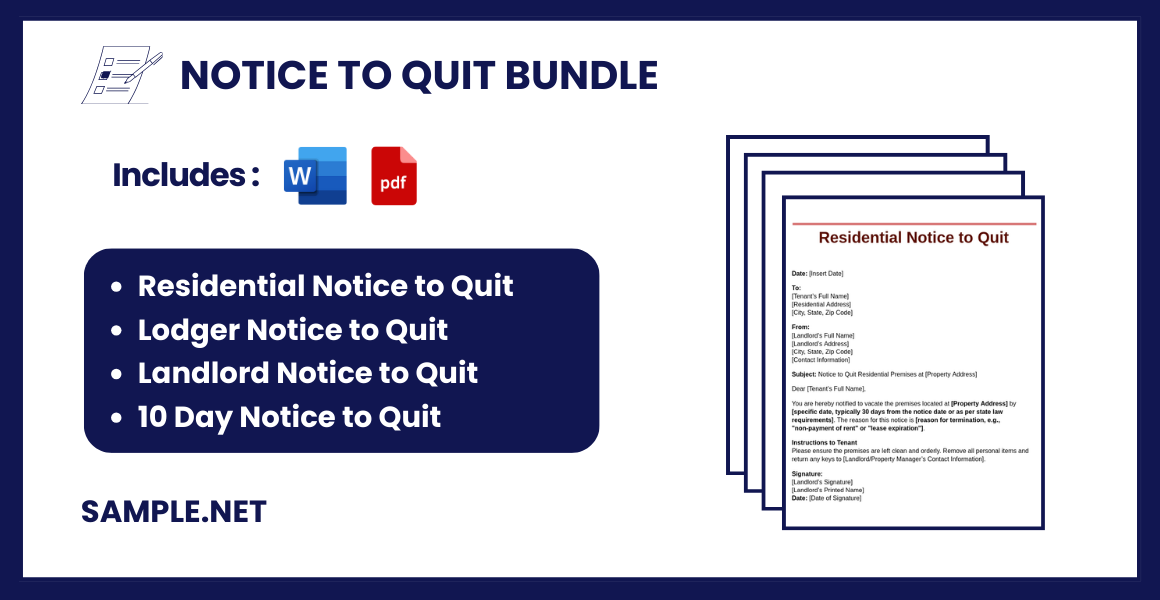
Download Notice to Quit Bundle
Notice to Quit Format
NOTICE TO QUIT
Date: [Insert Date]
To:
[Tenant’s Full Name]
[Tenant’s Address]
[City, State, Zip Code]
From:
[Landlord’s Full Name]
[Landlord’s Address]
[City, State, Zip Code]
[Contact Information]
Subject: Notice to Quit Premises at [Property Address]
Dear [Tenant’s Full Name],
This Notice to Quit is issued pursuant to the terms of the lease agreement between you, as the Tenant, and [Landlord’s Name], as the Landlord, for the premises located at [Property Address]. You are hereby notified of the following:
1. Reason for Notice
This notice is issued because [provide specific reason, e.g., “non-payment of rent,” “lease violation,” or “termination of lease without renewal”].
2. Date to Vacate
You are required to vacate the premises by [specific date, typically 30 days from the notice date, unless local law requires a different period].
3. Legal Rights
If you do not vacate the premises by the specified date, legal proceedings may be initiated to recover possession of the property, which could result in eviction.
Instructions to Tenant
Please remove all personal belongings, leave the premises in a clean and orderly condition, and return all keys to the Landlord or property manager by the specified vacate date.
Additional Information
If you have any questions or would like to discuss this matter, please contact [Landlord’s or Property Manager’s Contact Information].
Signature:
[Landlord’s Signature]
[Landlord’s Printed Name]
Date: [Date of Signature]
Notes:
- Ensure that the Notice complies with your local/state regulations, as notice periods and specific requirements may vary.
- Consider consulting with a legal professional if the situation is complex.
What is a Notice to Quit?
A Notice to Quit is an official document that landlords issue to tenants, informing them to vacate a rented property within a set period. This notice is used to formally terminate the lease, typically for reasons such as non-payment of rent, breach of lease terms, or end-of-lease arrangements. It is an essential step in the eviction process and serves as a legal record of the landlord’s intent to reclaim possession of the property. You can also see more on Tenant Notice
Types of Notices to Quit

1. Non-Payment Notice to Quit
This type of notice is issued when a tenant fails to pay rent within the agreed period. The document informs the tenant of overdue rent and typically gives them a specific timeframe to either pay the outstanding balance or vacate the property. If the tenant does not comply by paying the rent or leaving, the landlord can initiate eviction proceedings. You can also see more on Notice to Vacate.
2. Lease Violation Notice to Quit
A Lease Violation Notice to Quit is issued when the tenant breaches one or more terms of the lease agreement. Common violations include unauthorized subletting, keeping pets when prohibited, or causing property damage. This notice gives the tenant an opportunity to correct the violation or vacate. If the tenant does not rectify the breach, eviction may proceed.
3. End of Lease Notice to Quit
This notice is used at the conclusion of a lease term. The End of Lease Notice to Quit notifies the tenant that their lease will not be renewed, and they must vacate by the lease’s end date. It’s commonly issued in cases where the landlord does not wish to continue renting to the current tenant but does not necessarily have grounds for eviction. You can also see more on Termination Notice.
4. No-Cause Notice to Quit
In jurisdictions that permit it, landlords may issue a No-Cause Notice to Quit, especially for month-to-month rental agreements. This type of notice does not require the landlord to provide a specific reason for terminating the lease. However, it typically comes with a notice period (e.g., 30 or 60 days) that varies by local laws. Some areas have restrictions, requiring landlords to provide a valid reason for eviction.
5. Conditional Notice to Quit
A Conditional Notice to Quit is a type of notice issued to give the tenant a final chance to remedy specific issues, such as non-payment or minor lease violations. This notice allows the tenant to avoid eviction by meeting certain conditions, such as paying overdue rent within a specified timeframe. Failure to meet these conditions results in the initiation of the eviction process. You can also see more on Eviction Notice Forms.
How to Create a Notice to Quit
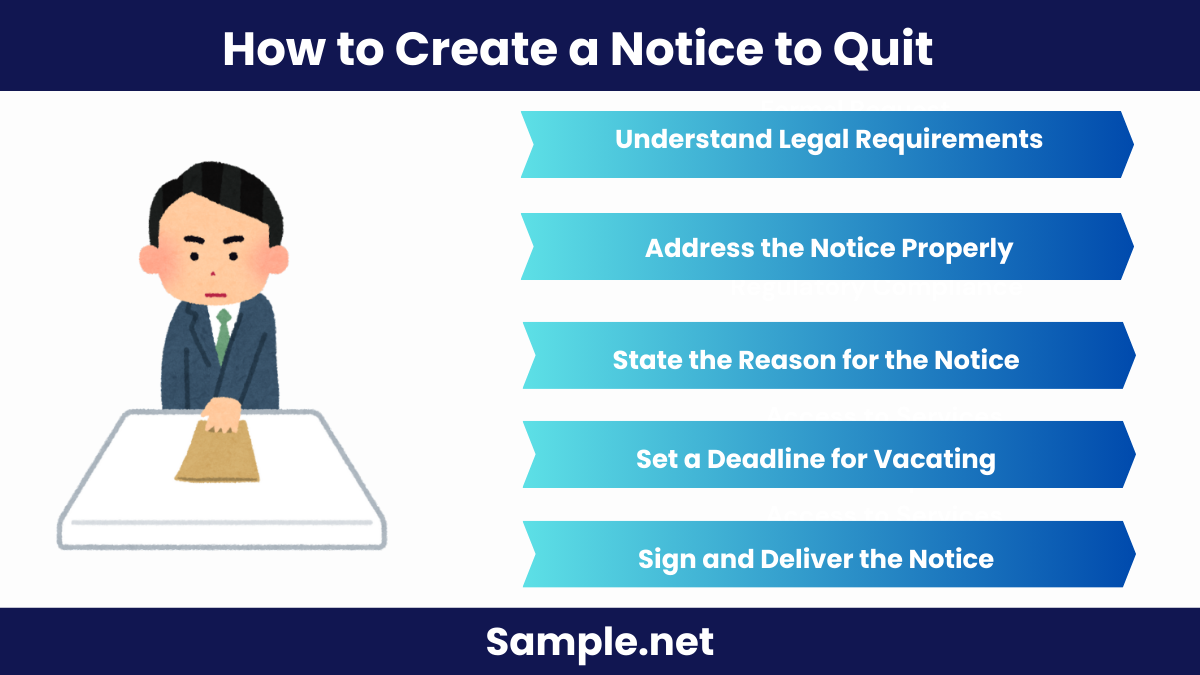
Step 1: Understand Legal Requirements
Start by familiarizing yourself with the specific laws in your area regarding Notices to Quit, as these vary widely. Different jurisdictions have different requirements for notice periods, valid reasons for termination, and legal language. Researching these details ensures that your Notice to Quit complies with local rental laws, reducing the risk of disputes or legal challenges. You can also see more on Vacate Notice.
Step 2: Address the Notice Properly
Make sure the notice is correctly addressed to the tenant(s) involved. Include their full name(s), the property address, and any other identifying information as required by local laws. This precise addressing is critical to avoid misunderstandings and ensure clarity on who the notice applies to, particularly in multi-tenant or shared-living scenarios.
Step 3: State the Reason for the Notice
Clearly specify the reason for the notice, whether it is due to non-payment of rent, a lease violation, or an end-of-lease termination. Providing specific reasons helps to keep the process transparent and adheres to legal standards. Ensure the reason aligns with the lease agreement and applicable local laws to avoid potential disputes. You can also see more on Eviction Notice.
Step 4: Set a Deadline for Vacating
Include a clear deadline by which the tenant must vacate the premises. This date should comply with the minimum notice period required by law and should be stated in an unambiguous way. For example, “Please vacate the property by [specific date].” This deadline establishes the urgency and the tenant’s legal obligation to leave within the specified timeframe.
Step 5: Sign and Deliver the Notice
Sign and date the notice to complete it formally. Make copies for your records, and deliver the notice in a legally acceptable manner, such as certified mail or hand delivery, depending on local requirements. This step provides you with proof of delivery, which is crucial should you need to proceed with eviction.
Issuing a Notice to Quit is a fundamental tool for landlords in managing rental agreements and addressing tenant-related issues legally. This document clarifies lease obligations and enables landlords to regain property control as needed. Following proper procedures in creating and serving a Notice to Quit is crucial for upholding landlord rights and ensuring tenants receive fair and legal notification. Understanding this process helps both parties navigate transitions smoothly and within the bounds of the law. You can also see more on 30 Day Notice.
FAQS
When can a landlord issue a Notice to Quit?
Landlords issue a Notice to Quit for various reasons, including non-payment of rent, lease violations, or at the end of the lease term as part of formal eviction procedures. You can also see more on Late Rent Notice.
How much notice must be given to tenants?
The notice period varies by location, commonly ranging from 7 to 30 days, depending on the reason and local regulations.
Can a landlord issue a Notice to Quit without a reason?
In some jurisdictions, landlords may issue a “No-Cause” Notice to Quit, typically in month-to-month leases. However, local laws vary, and some regions protect tenants from eviction without cause. You can also see more on Employee Notice.
What are the legal requirements for delivering a Notice to Quit?
A Notice to Quit must often be delivered via certified mail or hand delivery, with a documented receipt. This ensures legal proof of delivery, which is essential if the landlord needs to pursue further legal action.
What should a tenant do if they disagree with a Notice to Quit?
If a tenant disagrees with the notice, they should respond formally, ideally with the assistance of legal advice. Tenants can present their case, negotiate, or challenge the notice in court if they believe it’s unfair or incorrectly issued. You can also see more on Work Notice.
What is the difference between a Notice to Quit and an eviction?
A Notice to Quit is a preliminary step informing the tenant to vacate, while an eviction is a court-ordered process to remove the tenant if they fail to comply. You can also see more on Past Due Rent Notices.
